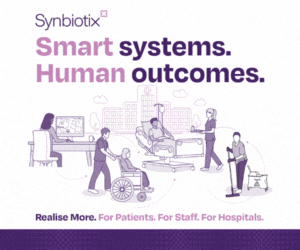Artificial Intelligence (AI) is a computer science discipline working towards replicating critical human mental faculties in intelligent machines. It has reached a level of capability and maturity where it could have a transformative impact on healthcare and other knowledge intensive sectors. The power, scope and scale of AI applications are increasing exponentially. Steve Wells (COO), Katherine Barnett (Editor) and Rohit Talwar (CEO) all from Fast Future Publishing, explore the current uses, emerging applications and future possible impact of AI in healthcare.
The technological revolution is already disrupting the healthcare industry globally. Incredible developments in the power and precision of new and emerging technologies are driving radical changes in diagnosis, drug development, treatment plans, surgery techniques, monitoring devices, Estates and Facility Management. Already there are remote patient monitoring devices that feed back their readings in real time; blood pressure, glucose levels, heart rates and more can all be tracked. Sub-miniature electronics have given rise to a ‘lab-on-a-chip’ diagnostic tool - only a few square millimetres in size - that can replicate many of the functions of an entire laboratory.
So, what’s next? Exponentially accelerating advances in science and technology are taking us to the next level and blurring the boundaries between science fiction and reality. For example, with a wry eye to the future, Qualcomm has offered a US$10 million X-prize for the invention that best replicates the Star Trek Tricorder medical instrument - the small handheld device that can diagnose all illnesses. Qualcomm expects entrants to diagnose over a dozen medical conditions - the winning submission will be announced in the second quarter of 2017.
In this era of ground-breaking technological innovations, special attention should be paid to the revolutionary developments enabled and promised by AI. Some are calling it mankind’s last invention because of its potential to reach a super intelligent status that far exceeds mankind’s capabilities. While that ultimate invention may be some way off, right now AI has the potential to disrupt the healthcare industry from the inside; to become embedded in every aspect of healthcare provision - bringing about monumental changes for patient and provider.
Artificial Intelligence
Key applications for AI include speech recognition, language translation, visual perception, learning, reasoning, inference, strategising, planning, decision-making and intuition. There are several underlying disciplines within the field of AI which include data mining, big data, rules-based (expert) systems, neural networks, fuzzy logic, machine learning (ML), deep learning (DL), cognitive computing, natural language processing (NLP), robotics and recognition of images, speech and video.
Currently the power and scale of AI technology is starting to drive significant developments within the healthcare sector. Already AI is being used for diagnosis and prediction, drug development, healthcare management - applications that are improving efficiency and cutting costs. As outlined in a previous article, we are already seeing staggering results in the use of AI technology in medical diagnosis and prediction. For example, the IBM Watson Health application can process, analyse and extrapolate inferences from huge amounts of data, and is already outperforming cancer experts in patient diagnosis.
In another development, Google DeepMind has launched DeepMind Health; in a five-year deal with the NHS, DeepMind Health will access NHS patient data to help develop and deploy its Streams healthcare app. This app will alert healthcare professionals to patients in most need, allow them to securely assign tasks and communicate about workload decisions. It aims to provide mobile viewing of results, patient medical histories and messaging; the alerts should speed up delivery of care and the hope is that the application will revolutionise the outdated model of task allocation by paper memos and fax machines. These are examples of what’s happening now - so what else is on the horizon?
Predictive diagnosis
The rapidly increasing processing power and functionality of healthcare AI applications will enable huge amounts of data from multiple sources to be aggregated, analysed and extrapolated - allowing ever more sophisticated and comprehensive insights, inferences and causal patterns to be identified. This underlying process may, in the very near future, change diagnosis and guide all subsequent patient interactions throughout treatment. These applications can draw input from a far more diverse range of sources than most humans would have the time, inclination - and possibly the capacity - to gather, analyse and interpret. For example, data can be combined from wearable devices, healthcare records, genetic information, family histories, food diaries, shopping purchases, patient income statements, public health sources and local authority databases.
By using a wide array of relevant information in a predictive and pre-emptive manner, we may be able to eradicate the notion of diagnosis as clinical practice that only takes place once symptoms have manifested. Instead, the predictive power of AI can be applied to these data sets to assess or predict the likelihood of conditions, diseases or illnesses that a patient might develop in coming years. This hyper-early prediction will allow sufficient time for interventions to take place, and with increasing success. Lifestyles can be altered, prophylaxis administered and special attention paid to the manifestation of indicative symptoms - enabling treatment to be initiated immediately if a health risk does indeed become apparent. This should deliver significantly better patient outcomes, and lower rates of admission to secondary care will put less burden on the NHS budget.
Patient pathway management
Enhanced patient pathway management is another key AI development we may see in the near future - which will have particular resonance in the UK from both a patient care and a funding perspective. As patients and their records transition through the healthcare system, there is the potential for administrative errors and issues. To help address this, an AI embedded in a patient’s smart device can use data collected from multiple sources; patient records, interactions, social media, and transactions can all be aggregated and processed to draw out potential patient behaviours.
In this scenario, AI systems would alert patients to take their medication, turn up to appointments, and provide them with information. This will be radically different from the current text update service that the NHS provides. Instead of a standard text to remind patients of appointment times, these nudges will be unique, personalised to the individual, use language they are accustomed to, and present information in a format that will be most easily understandable to that individual. In the near future, we may see this evolve from a text message to a GIF, image or animation that appears on a young person’s phone reminding them of their appointment, for instance.
Alongside helping the individual take action, the AI could also manage their time and appointments without them ever knowing. If a consultation needs to be booked and a patient allows access to the ever-smarter intelligent assistants (for example, future generations of Siri) on their smartphones, then the AI could look at the patient’s calendar and upcoming commitments, extrapolate data from their movements and lifestyle choices, and book a convenient appointment time. So, knowing a particular student habitually misses morning classes, the AI would schedule an afternoon consultation. There will be no need to enter this information, the AI will ‘know’ it from the deep inferences drawn from data analysis.
Such AI enabled applications in early diagnosis and patient management systems could radically improve outcomes, increase efficiency and cut costs significantly. The savings could be directed to more labour-intensive practices such as surgery and to funding critical research projects. Early successes with clear benefits from the adoption of AI applications could lead a rapid and potentially exponential increase in the usage, reach, scope, and impact of such smart tools across the health service.
Future innovation - radical convergence
Looking slightly further into the future, we may see AI embedded in all aspects of the healthcare process. For example, significant change could come by linking AI to blockchain technology. Blockchain is a form of distributed ledger technology, that is used to provide a super secure time-stamped immutable ‘block’ or record for each transaction, and which includes information from the previous record in the chain. This means transactions cannot be deleted or amended. Originally developed to record transactions undertaken in the bitcoin cryptocurrency, increasingly applications are being seen in tasks like transaction tracking in financial services. The combined application of AI and blockchain could radically alter the flow of funds through the entire healthcare system.
The existing funding system lacks the flexibility and sufficiently sophisticated technology solutions to allow for the concept of having the money actually following the patient throughout the system. In contrast, as the AI is planning pathways, directing patients and guiding medical intervention, the transactions and interactions can be tracked and time stamped using a blockchain. Such a blockchain will provide an immutable healthcare transaction record - allowing for instant identification of the funds available and the amount spent on a particular patient.
The furthest reaches of AI
On a 10 to 20 year horizon, it is possible that AI could protect individuals from any knowledge of their condition - allowing people to go about their daily lives blissfully unaware of all the technological magic that is happening behind the scenes to help them to stay fit, healthy and happy, should they so desire. At the other end of the scale, if the patient wants to know what is happening to them, they could be informed of the biological processes that may occur, told what symptoms may arise, what to expect and when to expect it.
As the AI learns about the patient by gleaning data and insight from multiple sources, it could determine salient personality traits from an individual’s data and interactions to discern who should be told what, when and how much. Taking this a step further, it is possible that an AI will be able to build an effective medicine regime tailoring the size and timing of dosage to have maximum effect given personal physiology. Using all the data about an individual, including their unique genetic code, drugs will be designed specifically for each patient.
The Revolution is underway
While we are at the very early stages of the adoption of AI in healthcare, the take-up is likely to accelerate - driven both by the proven benefits of AI technology and the potential to improve outcomes, increase efficient use of scarce resources and drive down the cost of delivering care.
As we look to the future, an increasingly sophisticated range of AI applications promises to deliver timely and completely individualised medical intervention with minimal resource wastage and to potentially revolutionise the funding structure of our healthcare system. This could herald a new age of intelligent care, one that takes a holistic view of every aspect of a human and directs advice, action and intervention to help ensure their total wellbeing. The ultimate goal here is not to become subservient to the machine, but rather to harness its immense potential in service of humanity.












